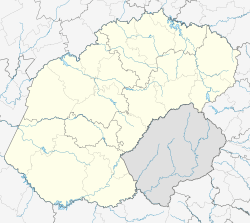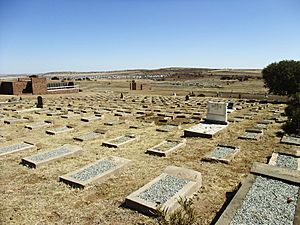Winburg facts for kids
Quick facts for kids
Winburg
|
|
|---|---|

Dutch Reformed Church, Winburg
|
|
| Country | South Africa |
| Province | Free State |
| District | Lejweleputswa |
| Municipality | Masilonyana |
| Established | 1835 |
| Area | |
| • Total | 63.5 km2 (24.5 sq mi) |
| Elevation | 1,430 m (4,690 ft) |
| Population
(2011)
|
|
| • Total | 1,373 |
| • Density | 21.622/km2 (56.00/sq mi) |
| Racial makeup (2011) | |
| • Black African | 41.0% |
| • Coloured | 3.0% |
| • Indian/Asian | 1.0% |
| • White | 52.8% |
| • Other | 2.2% |
| First languages (2011) | |
| • Afrikaans | 68.9% |
| • Sotho | 15.8% |
| • English | 8.0% |
| • Xhosa | 2.3% |
| • Other | 5.0% |
| Time zone | UTC+2 (SAST) |
| Postal code (street) |
9420
|
| PO box |
9420
|
| Area code | +27 (0)51 |
Winburg - Makeleketla is a small town in the Free State province of South Africa. It's known for its farms and is one of the oldest towns in the region.
Winburg was officially started in 1837. It is one of the first settlements in South Africa located north of the Orange River. It sits where two major highways meet: the N1 National Highway (connecting Johannesburg and Cape Town) and the N5 National Route. The city of Bloemfontein is about 120 kilometers south of Winburg.
Contents
History of Winburg
Early Settlers and Land Purchase
In 1835, a group of 11 early European settlers, called Voortrekkers, arrived in the Winburg area. Their leader was Andries Hendrik Potgieter.
In 1836, they bought land between the Vaal and Vet rivers. This area makes up most of the northern Free State today. They bought it from the local Bataung Chief, Makwana. In return, they promised to protect his people from other tribes. They also gave him 42 cattle.
Choosing the Town's Location
Within a year, over 1,000 settler families had moved to the region. They needed a central place for their community and religion. However, the Voortrekker leaders disagreed on where to build this town.
In 1841, they held a vote. The group led by Andries Pretorius won. They chose the current spot for the town. This land was a farm called Waaifontein, meaning "windy spring."
Legend says the town was named Wenburg ("victory town") to celebrate this win. It's also said that the spot chosen by the losing group is still called Mompeling, meaning "muttering." Another idea is that the name celebrates a Voortrekker victory over the Ndebele people in 1837.
Winburg's Role as a Capital
Before 1843, Winburg was part of the Boer Republic of Natalia. This was an early independent state. When the British took control of Natal in 1843, Winburg became the first capital of the Voortrekker republic of the Orange Free State.
In 1872, Winburg became an official municipality. By then, the capital had moved to Bloemfontein. Still, Winburg remained an important center for the local settlers.
The Voortrekker Monument
Winburg was first chosen as the site for the main Voortrekker Monument. This monument honors the Voortrekker settlers. However, Pretoria was chosen instead for the main monument.
So, a smaller, five-tiered monument was built on the edge of Winburg in the 1950s. It has the names of five Voortrekker leaders: Piet Uys, Andries Hendrik Potgieter, Andries Pretorius, Piet Retief, and Gerrit Maritz. The different lengths of the monument's tiers show the distances each settler group traveled. This monument is near the birthplace of Martinus Theunis Steyn. He was a president of the Boer Republic of the Orange Free State.
Winburg During the Second Boer War
The Second Boer War was a conflict between the British and the Boer republics. During this war, the British set up a camp in Winburg. This camp was for Afrikaner civilians, mostly women and children. They were brought there by British forces who were destroying farms and homes.
Life in the camp was very difficult. Many people, including 132 adults and 355 children, sadly died in the camp. This was due to illness and tough living conditions, especially during winter. There was also another camp nearby called "Balla Bosiu," which means "where they cry at night." This camp housed Black people.
A famous Boer commander, Koos de la Rey, was born near Winburg on a farm called Doornfontein. He was a general for the Boer commandos. He fought against British forces from 1899 to 1901. A Black military unit was also formed in Winburg during the war. This unit fought alongside the British.
Images for kids





